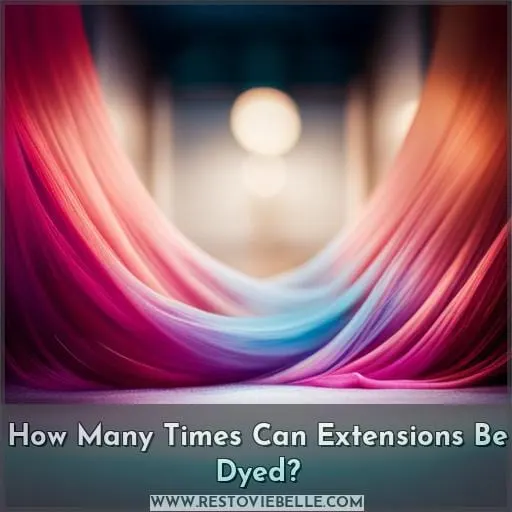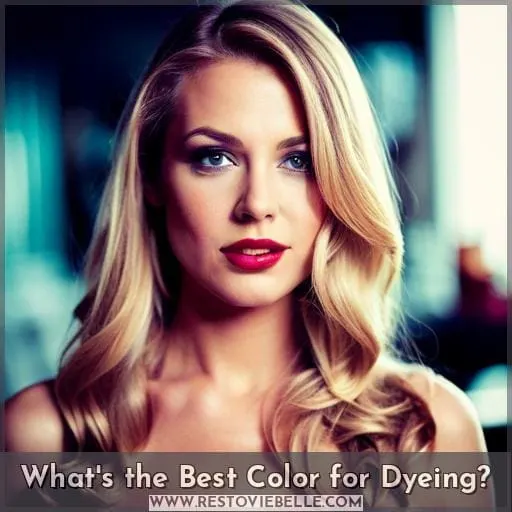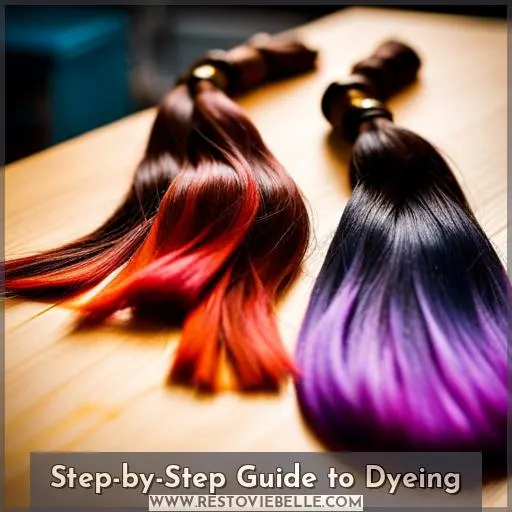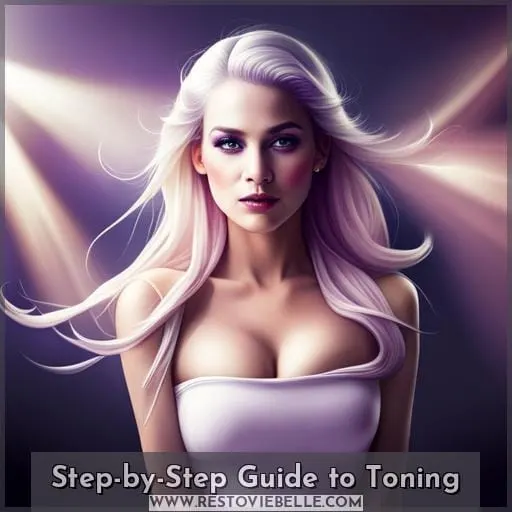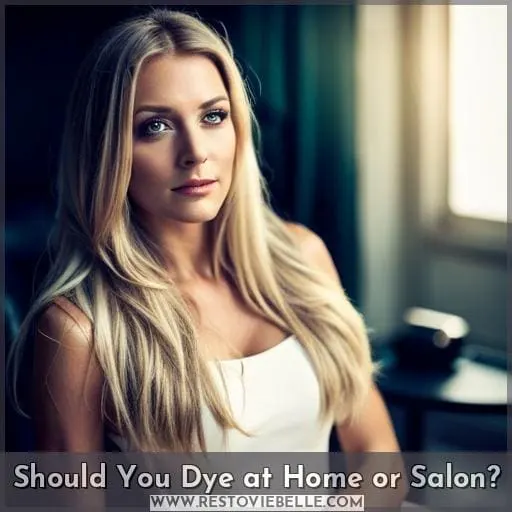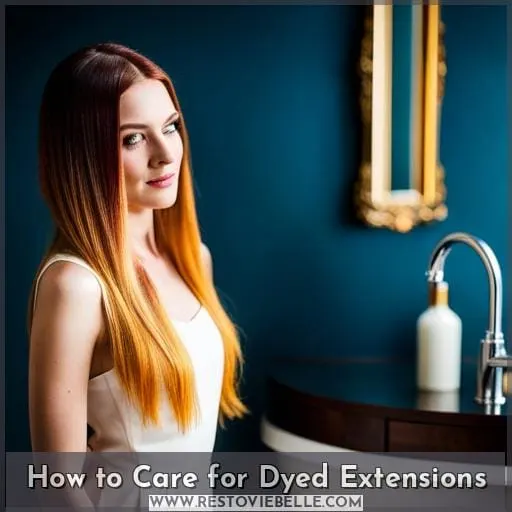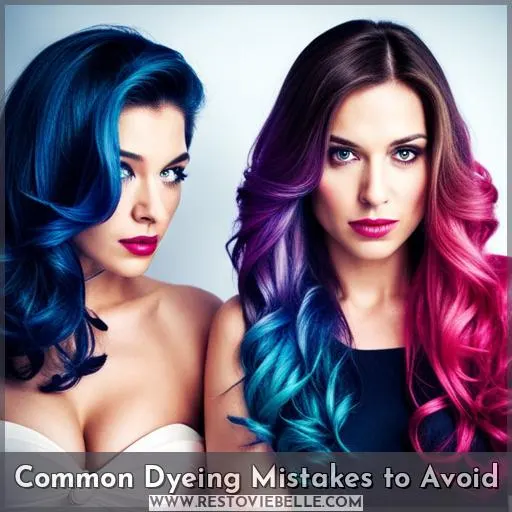This site is supported by our readers. We may earn a commission, at no cost to you, if you purchase through links.
 A stitch in time saves nine when it comes to dying those luscious locks of yours. Snipping in extensions opens up a world of color, letting you refresh your hue on a whim without damaging your natural hair.
A stitch in time saves nine when it comes to dying those luscious locks of yours. Snipping in extensions opens up a world of color, letting you refresh your hue on a whim without damaging your natural hair.
But before you break out the dye, arm yourself with the proper tools and know-how so you can keep your faux follicles fab. With the right tips on prepping, mixing, timing, and maintaining, you’ll have healthy, harmonized hair in no time.
Table Of Contents
- Key Takeaways
- What Hair Extensions Can You Dye?
- Can You Dye Clipped in Extensions?
- How Many Times Can Extensions Be Dyed?
- What’s the Best Color for Dyeing?
- Step-by-Step Guide to Dyeing
- Step-by-Step Guide to Toning
- Should You Dye at Home or Salon?
- How to Care for Dyed Extensions
- Common Dyeing Mistakes to Avoid
- Frequently Asked Questions (FAQs)
- Conclusion
Key Takeaways
- Remy human hair extensions can accept dye, while synthetic hair cannot be dyed. Bleaching is not recommended.
- Limit dyeing to 1-2 times per year max to avoid excessive dryness and breakage. Touch up roots between full dye jobs.
- Seek professional help for intricate dyeing processes like ombre or dramatic color changes. Experts provide guidance on challenges.
- Follow best practices like strand testing, using color depositing shampoos, and seasonal color palettes for natural vibrancy over time.
What Hair Extensions Can You Dye?
When considering dyeing hair extensions, the first question is what type of hair can actually be colored.
While 100% remy human hair extensions can successfully accept dye, synthetic or artificial hair can’t undergo chemical processing.
Bleaching extensions is also not recommended since most are pre-lightened during manufacturing, and further lightening severely damages the hair structure leading to breakage.
Remy Vs Synthetic
You can dye Remy or 100% human hair extensions, but can’t dye synthetic or artificial hair.
Remy hair, harvested from a single donor, retains cuticles facing the same direction for a natural look. However, Remy misconceptions abound – while considered the gold standard, Remy requires proper maintenance like pre-softening and sealing wefts before dyeing.
Synthetics can’t take dye due to a different chemical composition. Instead, opt for pre-colored synthetic options.
When dyeing extensions at home, begin cautiously – perform strand tests with semi-permanent color, monitoring any reactions before full saturation. Limit dyeing sessions to preserve quality. Consult a stylist for guidance on meeting coloring challenges.
With the right prep and aftercare using sulfate-free shampoo, you can refresh your Remy hair and maintain vibrancy.
Bleaching Not Recommended
After covering Remy versus synthetic hair, you shouldn’t bleach extensions as it causes severe damage.
- Most extensions undergo bleaching during manufacturing already.
- Using additional bleach weakens hair, leading to breakage.
- Consider healthy alternatives like natural toning instead.
- Bleach-free options help maintain color and extension quality.
Rather than risking severe damage through DIY bleaching challenges, focus on color maintenance with natural toning or professional help for the best outcome when dyeing the remy human hair used in high-quality extensions.
Can You Dye Clipped in Extensions?
The possibility exists of dyeing clipped-in extensions, but exercise caution regarding contact with attachments during processing.
When dyeing clipped-in hair, you’ll want to avoid getting color on the clips themselves as it can degrade the adhesive and structure over time. Work in sections, securing other areas with clips, applying dye only from mid-shaft down.
| Season | Ideal Colors |
|---|---|
| Spring/Summer | Pastels, Blondes |
| Fall/Winter | Rich Browns, Reds |
As seasons and color trends change, you may want to switch up your extension hue. But limit dyeing sets to 1-2 times a year max to prevent dryness and breakage. Always do a test strand first. Seek professional help for tricky processes like ombre. And know that with frequent installation/removal, fading may occur even with properly dyed human hair extensions.
Maintain vibrancy with color depositing treatments. Ultimately, exercise care during dye jobs and heed aftercare steps for long-lasting, blendable color.
How Many Times Can Extensions Be Dyed?
After discussing whether clipped in extensions can be dyed, it’s important to cover how often extensions should be colored. While the urge may be strong to frequently change up your look, over-dyeing extensions can ruin them.
When dyeing extensions:
- Test a small section first before applying dye to the full set. This helps gauge the color result and minimize potential damage.
- Limit dyeing frequency to 1-2 times at most. Frequent dyeing severely compromises hair integrity.
- Touch up your roots only if needing a quick refresh between full dye jobs. Precision application preserves the rest.
- Consult a professional hair colorist from the start. They can best advise on dye options suited to the extensions, preserving their lifespan.
Following professional advice, you can explore different colors without overtaxing the extensions. The watercolor method also deposit color gently. Ultimately, balance your desire for change with the extensions’ capacity.
What’s the Best Color for Dyeing?
Since you want the dye to adhere properly and last, light blonde extensions make the best base for vibrant or pastel shades, while light brown allows rich brunette hues.
When deciding what color to dye your hair extensions, consider what final shade you desire.
Light Blonde extensions that have undergone minimal processing serve as the optimal base for daring, punchy colors like cotton candy pink or mint green, allowing the pigment to pop.
For those seeking deeper, richer brunette shades, Light Brown extensions make an ideal canvas, as the warm base embraces lush chocolate and espresso shades.
An informed choice sets you up for hair color success.
Before committing to a dramatic dye job, experiment with semi-permanent options, gradually building up intensity for less risk. And if venturing into serious color transformations, seek professional help to avoid damage.
With reasonable precautions, extensions unlock thrilling hair versatility.
Step-by-Step Guide to Dyeing
You’ll need to gather your supplies first, including gloves, dye, developer, bowl, brush, foil, and more.
Next, thoroughly mix the color and developer according to the instructions before sectioning hair and applying.
Finally, cover sections in foil or plastic wrap once saturated for even processing and optimal color adherence.
Supplies Needed
Before dyeing your hair extensions, you’ll need to gather:
- Hair color
- Developer
- Gloves
- A color bowl
- Tin foil
- Plastic wrap
- A comb
- A towel
To achieve even color distribution and optimal results:
- Follow the manufacturer’s instructions when mixing the hair dye. Adjust quantities depending on length and density of extensions.
- Section out extensions to focus on small areas at a time during application.
- Perform a strand test first to check the color result before applying to all hair.
This will allow for precise application control while protecting other hair from over-saturation. Consult a professional if unsure about proper mixing ratios or application techniques when dyeing extensions at home.
Mix and Apply Dye
You’ll combine the prepared dye mixture and use a tinting brush to saturate strands, steering clear of attachment points.
| Mixing Technique | Application Tips | Color Blending |
|---|
Follow instructions
Adjust consistency
Check saturation
Apply hair color starting from the top of the head, using downward brush strokes. Mix the color well and follow timing guidance. Rinse extensions thoroughly with cool water, running fingers through to remove excess dye.
Style extensions to complement your natural hair, taking extra care to protect colored strands. Experiment with changing hair color, but exercise caution to avoid potential damage from overprocessing.
Step-by-Step Guide to Toning
When toning hair extensions, first mix your preferred toning shampoo with lukewarm water to dilute it.
Process the toner for 1-2 minutes before thoroughly rinsing each section of hair.
Follow up with your usual conditioner to lock in moisture after removing the toner.
Mix Toning Shampoo
You should frequently mix the toning shampoo with lukewarm water before applying it to the hair extensions.
- Combine equal parts toning shampoo and water for lighter toning or increase concentration for more pigment deposit.
- Mix thoroughly until an even color is achieved, with no streaks remaining.
- Dip a tinted brush into the solution, coating the bristles evenly.
- Use clips to separate hair sections for precise application, avoiding contact with attachment areas.
Process strands for 1-2 minutes maximum before rinsing thoroughly to reveal refreshed, balanced color devoid of brassiness. Tone hair biweekly, experimenting with tonal variations until the desired shade is perfected.
Seek professional guidance to troubleshoot color corrections or unexpected dyeing mistakes like unintentional oxidative darkening.
Processing Time
After mixing the toning shampoo, leave the extensions in the diluted mixture for 1-2 minutes to allow for even toner deposit. This ideal processing time enables the pigments to penetrate each strand while avoiding undertones.
For the best results, separate sections to ensure consistency across all pieces. Check a subtle change under lighting before rinsing thoroughly—going too long risks brassiness.
When combing damp hair, visualize your end goal; correct toning brings you closer. Nourish strands post-wash for optimal vibrancy and longevity of your personalized, complementary hue.
Should You Dye at Home or Salon?
Once you’ve finished toning the extensions, consider whether DIY application or professional salon services are the better choice for dyeing your hair pieces.
While dyeing extensions at home can save time and money, the process requires care to avoid potential damage. Approach DIY coloring only if you’re confident working with hair dye and the extensions are 100% Remy human hair.
Opt for salon services if the instructions seem complex or risks outweigh the benefits. Hair colorists have expertise in formulation, application techniques, and correcting mistakes.
For more natural-looking waves and glossy-looking shine, ask about incorporating balayage, babylights, or highlights. With professional guidance, you’ll get beautiful, dimensional color that blends seamlessly with your natural hair.
How to Care for Dyed Extensions
How properly should you care for your newly dyed hair extensions to maintain color vibrancy and hair health?
- Use sulfate-free shampoo and conditioner to retain color brightness and moisture levels.
- Apply a weekly deep conditioning hair mask focused on hydration.
- Allow hair to air dry instead of heat styling to prevent damage and fading.
- Massage the scalp when washing to stimulate blood circulation for optimal health.
- Adjust your hair care routine seasonally as humidity and temperature impact dyed hair.
Transitioning to lower-sulfate products is key for preserving the richness of dyed extensions. Deeply nourishing masks boost shine while discouraging dryness and breakage. Letting hair air dry naturally keeps the cuticle closed for better color retention over time.
A vigilant scalp care regimen boosts strength from root to tip. As seasons change, be mindful of environmental factors like moisture in the air interacting with color treated hair.
Common Dyeing Mistakes to Avoid
When dyeing your extensions, you’d best avoid uneven saturation, as this can lead to splotchy results. For optimal color payoff and saturation, apply dye in sections, ensuring full coverage from roots to ends.
Common Dyeing Mistakes to Avoid
| Mistake | Solution |
|---|---|
| Uneven saturation | Apply dye in sections for full, even coverage |
| Overlapping dye | Work methodically to avoid re-coating areas |
| Excessive heat | Limit use of hot tools to reduce damage |
| Aggressive brushing | Use a wide-tooth comb for gentle detangling |
| Skipping deep conditioning | Moisturize after each wash to avoid dryness |
You want rich, vibrant color without damage, so mind your technique.
- Separate extension pieces and brush through knots beforehand.
- Mix dye following instructions, then apply it strand-by-strand downwards from root to tip.
- Ensure full saturation, but don’t overdo it.
- Process for the recommended development time, then rinse thoroughly in cool water.
- Limit heat styling and regularly condition to protect your investment in fabulous hair!
Choosing quality extensions and conscientious coloring gives you glamorous, customizable length while avoiding ruined hair.
Frequently Asked Questions (FAQs)
What are the best brands of hair dye for extensions?
When dyeing hair extensions, always use professional salon brands like Wella, Schwarzkopf, Redken, or Matrix.
Follow instructions precisely and do strand tests first.
For best results, consult a professional stylist.
How long does the hair dye last on extensions?
The longevity of hair dye on extensions depends on several factors.
Carefully follow application and processing directions.
Use quality salon dye and avoid repeated dyeing to help the color last 4-6 weeks.
Handle extensions gently, use sulfate-free shampoo, and avoid heat styling to extend color vibrancy.
Regular toning maintains richness between dye jobs.
Can I dye my extensions back to their original color?
Yes, you can dye your extensions back to their original color.
Carefully follow the dye instructions to match the original shade.
Test a small section first before applying to all hair.
Handle gently and keep dye off attachment points.
Seek help from a colorist for best results restoring original color.
What damage can dyeing cause to hair extensions?
Dyeing extensions incorrectly risks severe damage.
Use professional help for optimal safety, avoiding overlapping lightener applications that increase fragility.
Handling requires care when wet to prevent breakage.
What extra products or tools do I need for dyeing extensions at home?
You’ll want a tangle-free brush, hair clips, gloves, developer, color bowl, foils, plastic wrap, fine tip brush, and towel.
Carefully section hair before applying color.
Follow timing directions.
Rinse thoroughly.
Condition to restore moisture and minimize damage.
Handle extensions gently when wet.
Conclusion
When it comes to dyeing extensions, tread carefully to avoid disaster.
Test strands first and follow timing guidelines religiously.
Use quality dyes and care for colored hair properly.
Skipping steps spells trouble for blended hues.
But armed with the right intel, you can refresh your locks on a whim.
So take the plunge into a colorful mane without damaging your natural hair – just keep your wits about you.



